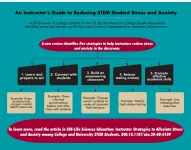A genetic patch to prevent hereditary deafness
Research in Radboudumc shows that a therapeutic approach for DFNA9 can work
2021-03-02
(Press-News.org) They can hear well up to about forty years old, but then suddenly deafness strikes people with DFNA9. The cells of the inner ear can no longer reverse the damage caused by a genetic defect in their DNA. Researchers at Radboud university medical center have now developed a "genetic patch" for this type of hereditary deafness, with which they can eliminate the problems in the hearing cells. Further research in animals and humans is needed to bring the genetic patch to the clinic as a therapy.
Hereditary deafness can manifest itself in different ways. Often the hereditary defect (mutation) immediately causes deafness from birth. Sometimes, as with DFNA9, you experience the initial problems in hearing after forty, fifty, sixty years. This has everything to do with the way DFNA9 mechanistically works. Every person gets half of his genes from his father and the other half from his mother. If you have two healthy copies of the DFNA9 gene, your inner ear works normal. If you receive a mutated copy of the gene from either your father or mother, deafness will develop later in life.
Protein spaghetti
Erik de Vrieze and Erwin van Wijk, both researchers at Hearing & Genes of the department of Ear, Nose and Throat, have conducted extensive research into the condition. De Vrieze: "We now know that you actually produce enough of the associated DFNA9 protein with just one healthy gene copy to be able to hear well for life. But there is a catch with this condition. The mutated protein is, in a way, disturbing the function of the healthy protein. It sticks to it, so that the healthy protein can also no longer do its job. This clumped protein spaghetti is constantly being removed by the cells of the inner ear, but after decades the clean-up service in these cells is reaching its limit and can no longer cope with these protein clumps. A threshold value is exceeded. As a result, the waste accumulates, the hearing cells start to function poorly and even die over time. After years of normal hearing, DFNA9 patients suddenly notice that their hearing is deteriorating, and sometimes deteriorating very quickly. Until at some point they will become deaf. "
Enough time for treatment
The specific DFNA9 mutation seems to originate from a common ancestor in the Southern Netherlands, somewhere at the end of the Middle Ages. This can more or less be deduced from the spread of the fairly unique clinical manifestation, which is now estimated to occur in about 1500 people in the (southern) Netherlands and Belgium. Perhaps even more important than the origin of the disease is whether or not anything can be done about it. Van Wijk: "This condition has two favorable characteristics for therapy development. Firstly, it is a hereditary condition that only manifests itself after a few decades in life. In case an effective treatment will become available for this disease, a sufficiently large timeframe is available to apply it before the hearing loss really strikes. "
Turning off mutant gene
The other point - developing an effective therapy - is a bit more complicated, but offers good starting points. Van Wijk: "The idea is that by specifically turning off the mutated gene copy you can prevent deafness. Without this mutated gene copy, no mutant protein will be produced and protein clumping will no longer take place. In addition, one healthy gene copy alone produces enough protein to maintain good hearing. "
Genetic patch
De Vrieze and Van Wijk further developed this idea. Together with colleagues, they have now published the research results in the scientific journal Molecular Therapy - Nucleic Acids. "Genes, that reside on our DNA, provide the genetic code for the translation process into proteins," says De Vrieze. "To get from a gene to a protein, you always need a translation process via so-called messenger RNA. And that is exactly the process we focused on. The unique DNA error in the DFNA9 gene is also reflected in the RNA. We developed a small piece of RNA that specifically binds to the messenger RNA derived from the mutated DFNA9 gene. As a result, the entire mutated messenger RNA is targeted for degradation. In this way, an essential link is lost and the mutant DFNA9 protein is no longer or hardly produced. The piece of RNA that we stick on the mutated DFNA9 messenger RNA is named an antisense oligonucleotide or "genetic patch".
Perspective!
In recent years, De Vrieze and Van Wijk have not only developed this genetic patch, but also investigated its effect in cultured cells. Their current article is mainly describing these results, as the approach works in cultured cells. So there is a "proof of concept", as it is called in science. In short, the research shows that the approach works at the cellular level.
Arthur Robbesom of the "The Ninth of ..." DFNA9 Foundation is delighted with the study. "This offers a real perspective for about 1,500 people in the Netherlands and Belgium who are suffering from this condition. "The foundation is also closely involved in this research. Robbesom:" Now it is important to take the next necessary steps in the research as soon as possible. We will wholeheartedly support you."
INFORMATION:
ELSE PRESS RELEASES FROM THIS DATE:
2021-03-02
Philadelphia, March 2, 2021--Taking the first deep dive into how the immune system is behaving in patients with multisystem inflammatory syndrome in children (MIS-C), researchers at Children's Hospital of Philadelphia (CHOP) and the Perelman School of Medicine at the University of Pennsylvania have found that children with this condition have highly activated immune systems that, in many ways, are more similar to those of adults with severe COVID-19. The results, published today in Science Immunology, show that better understanding the immune activation in patients with MIS-C could not only help better treat those patients but also improve treatment for adults with ...
2021-03-02
A new study of patients with Multisystem Inflammatory Syndrome in Children (MIS-C), a rare but severe complication of COVID-19 in children, reveals distinct immune features of COVID-19 not seen in adults that may clue scientists in to why SARS-CoV-2 infection manifests differently in children compared with adults. Their results showed that although the immune landscape in pediatric COVID-19 was similar to that in adults, MIS-C patients uniquely exhibited increased activation of a blood vessel-patrolling CD8+ killer T cell subset, and all pediatric COVID-19 patients harbored greater B cell frequencies for a more prolonged period of time than observed in healthy adults. MIS-C is characterized by pervasive inflammation, an array of symptoms ranging from fever ...
2021-03-02
Orange, Calif. - Even before the COVID-19 pandemic, college students were reporting record levels of stress and anxiety. According to the American College Health Association END ...
2021-03-02
The Deepwater Horizon disaster began on April 20, 2010 with an explosion on a BP-operated oil drilling rig in the Gulf of Mexico that killed 11 workers. Almost immediately, oil began spilling into the waters of the gulf, an environmental calamity that took months to bring under control, but not before it became the largest oil spill in the history of the petroleum industry.
Nearly 10 years have passed since then, and the oil slick has long since dispersed. Yet, despite early predictions, area wildlife are still feeling the effects of that oil, and research published in Environmental Toxicology and Chemistry has shown that negative health impacts have befallen not only dolphins alive at the time of the spill, but also in their young, born years later.
A team of researchers, including ...
2021-03-02
When central nervous system cells in the brain and spine are damaged by disease or injury, they fail to regenerate, limiting the body's ability to recover. In contrast, peripheral nerve cells that serve most other areas of the body are more able to regenerate. Scientists for decades have searched for molecular clues as to why axons -- the threadlike projections which allow communication between central nervous system cells -- cannot repair themselves after stroke, spinal cord damage, or traumatic brain injuries.
In a massive screen of 400 mouse genes, Yale School of Medicine ...
2021-03-02
Disruptions in the circadian rhythms in lung cells may explain why adults who survived premature birth are often more at risk of severe influenza infections, suggests a study in mice published today in eLife.
Dramatic improvements in the care of infants born prematurely have allowed many more to survive into adulthood. Yet ex-preemies can face several long-term side effects of the life-saving care they received. The study suggests potential new approaches to treating lasting lung problems in those born prematurely.
Many premature infants are not able to breathe on their own and require oxygen to survive. ...
2021-03-02
College course syllabi written in a warm, friendly tone are more likely to encourage students to reach out when they are struggling or need help, a new study from Oregon State University found.
Conversely, when a syllabus is written in a more cold, detached tone, students are less likely to reach out.
The study also compared the effect of syllabus tone with the effect of a deliberate "Reach out for help" statement included in the document.
"The instructor has to ask themselves, what's the first point of contact with the class for the student? In an online class and in remote learning, the syllabus is often the ...
2021-03-02
The United States experiences more tornadoes than any other country, with a season that peaks in spring or summer depending on the region. Tornadoes are often deadly, especially in places where buildings can't withstand high winds.
Accurate advanced warnings can save lives. A study from the University of Washington and the National Oceanic and Atmospheric Administration describes a new way to rate and possibly improve tornado warnings. It finds that nighttime twisters, summer tornadoes and smaller events remain the biggest challenges for the forecasting community.
"This new method lets us measure how forecast skill is improving, decreasing or staying the same in different situations," said Alex ...
2021-03-02
A recent study of how human resources professionals review online information and social media profiles of job candidates highlights the ways in which so-called "cybervetting" can introduce bias and moral judgment into the hiring process.
"The study drives home that cybervetting is ultimately assessing each job candidate's moral character," says Steve McDonald, corresponding author of the study and a professor of sociology at North Carolina State University. "It is equally clear that many of the things hiring professionals are looking at make it more likely for ...
2021-03-02
p>
Boulder, Colo., USA: Several new articles were published online ahead of
print for Geology in February. Topics include stress in survivor
plants following the collapse of land ecosystems, the Gulf of Aden, whether
the Denali fault is still active, the first reported Burgess Shale-type
fauna rediscovered, and redefining the age of the lower Colorado River.
These Geology articles are online at END ...
LAST 30 PRESS RELEASES:
[Press-News.org] A genetic patch to prevent hereditary deafness
Research in Radboudumc shows that a therapeutic approach for DFNA9 can work

